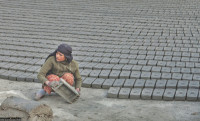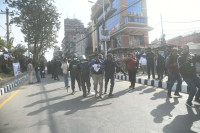Opinion
A fresh start
The government’s plan to train 50,000 youths for construction in quake-affected districts is a challenging task
Rommel J Pun
The current annual budget 2015/16 of Nepal aims to impart skills to 50,000 youths through Skill Development Training Centers. This ambitious plan is based on the rationale that doing so will help reconstruct or rebuild the 602,257 totally destroyed and 285,099 partially destroyed houses by the quake in the 14 most-affected districts.
There are a number of nation-wide skill development projects currently being implemented by various agencies (governmental and non-governmental) in both earthquake-affected and non-affected districts across the country. Six nation-wide skill development projects that have been in implementation since 2008 (some till 2018) target more than 250,000 rural youths; three of these national level projects ended in 2013.
Uphill task
Skill training projects in Nepal are primarily targeted at local employment markets across the country that are in the early stages of industrial development. People trained in those skill development projects are making up for the absence of human resource in the rural labour market due to the outmigration of Nepalis. After the quake, the skill development sector has had to suddenly take up the enormous task of reconstruction and rebuilding in quake-affected districts. Against this backdrop, there are a few questions that come to mind: how will the earthquake-affected districts benefit from the skill training projects? Will the earthquake-affected households be able to pay for the construction wages of skilled tradesmen? Or does the government plan to meet these costs through the Rs 91 billion allocated for
reconstruction?
Let us analyse the government’s plan from an implementation point of view. It would be an huge task for the government agencies to impart skill training to 50,000 youths, more so in quake-affected districts due to inadequate human resource and management expertise. Therefore, it is crucial for the National Reconstruction Authority ito be given a role to fulfil this skills gap. A public-private partnership would be equally important.
Another way to successfully implement the programme would be to request those with sufficient skills training experience to focus their activities in the quake-affected areas and to assure them that they will receive additional incentives if those skill development programmes generate short-term impacts. The national-level skill training projects (currently in operation) have adequate and competitive human resource to generate ideas and develop project components focusing on reconstruction and rebuilding. They have established and experienced networks all over the country to fulfil this obligation from a social, technical and livelihood aspect as well.
Possible solutions
The government has issued directives that all development activities within the earthquake-affected districts need to first get endorsed from the line ministries and district authorities. This is a good move as it will make it easy to identify the needs and prioritise the required development of required skills. And a good skill assessment framework can be developed with the backing of the National Reconstruction Authority and expert national or international organisations, including the Council for Technical Education and Vocational Training (CTEVT). Those quake-affected districts that come up with the most reasonable and practical skill assessment report could then be prioritised by the government to implement the programmes. Below are some ideas to develop the skill assessment framework:
First, there is a need to identify key infrastructure projects in quake-hit districts and categorise them into large, medium and small to assess the level of damages. Then there’s a need to assess the types of damage caused by the quake, the need for skilled human resource, tentative cost to rebuild the structure and the time required to restore the project. Second, though the surveys of houses fully and partially affected by the quake have either been completed or are ongoing in the affected districts, a complete profile of the districts is still not available. Such information would provide a holistic picture to the stakeholders and help them select the districts and Village Development Committees (VDCs) for reconstruction accordingly.
Third, we need to distinguish between the reconstruction and rebuilding activities of public entities (school and community buildings, government offices, roads, bridges) and private entities (houses, hotels and resorts, schools and colleges, hydropower companies). Then after ascertaining the destruction, it would be easy to recommend the required work: masonry, wood work, mechanical and electrical skills.
Fourth, there is a need to identify and classify occupational skills. The findings on the devastation of public and private entities would enable stakeholders to figure out the skills required for the job. The required skills can vary from general/basic skills to specialised skills—ability to operate equipments and machinery.
Fifth, there is a need to collect the data of available workforce within the VDC or district and classify them as skilled and unskilled workforce. Though it is not easy to collect such data, a tentative figure can be determined based on the existing population and economic background. To that end, CTEVT could provide secondary information of available skilled workforce through the National Skill Certification database of the quake-hit districts.
Sixth, based on the data of skilled and unskilled workforce, we could provide general/basic skills training to the unskilled workforce and similarly provide skills upgrading courses or multi-skilling to the available skilled workforce.
Lastly, there is a need to fix the minimum salary and wages to be provided to the workers. Provindg direct incentives to the skilled and unskilled workforce surpassing the national threshold (minimum wage) may stimulate economic activities in the affected areas. This could discourage the unskilled and semi-skilled workforce from leaving the country for overseas employment too. The National Reconstruction Authority will need to enforce such a policy to promote the economic activities through encouraging workforce (from the affected districts) to fill in the gap of skilled workforce.
Pun is a promoter of skill training projects in Nepal




 18.12°C Kathmandu
18.12°C Kathmandu










